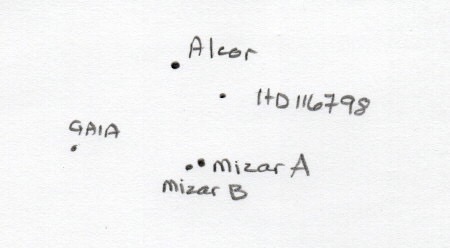Stars: Albireo β1, Albireo β2, Alcor-Mizar, Arcturus, CN Boo, Mizar A, Mizar B, V369 Sct, GLP14
Bayer Designation (BD): 013247, 034029,
GAIA: 15635927440110133120
HD Stars: 116798, 124772, 125409, 125450, 125771, 151123, 151258, 151526, 151630, 152906, 152997, 153240, 159860, 159307, 159628, 159676, 159891, 159928, 160120, 174281, 174282, 183560, 183987, 338433
HR: 5346
SAO: 87310, 142703
TYC: 2138-0057-1, 5054-0658-1
Location: Home
Date: 2022-07-22/23
Time: 9:30 PM - 1:15 AM ADT
Equipment: EVOSTAR 80ED Telescope
Eyepieces: Explore Scientific 82º APOV 4.7 mm, Antares Plössl 15 mm, Sky-Watcher UWA-58º 5 mm
Transparency: Excellent (5)
Seeing: Very Good (4)
Temperature: 22º C - 19º C
SQM: 19.15 - 19.62
This was the first time using my new-to-me go-to EVOSTAR 80 ED on a brand new AZ-GTI mount on its tripod. It was quite steady. Jerry and I were 'playing' with the star alignment options before delving into observing.
|
Mizar + Alcor + HD 116798 Once again, I looked for the double stars Mizar and Alcor to also find their 3rd smaller and dimmer companion HD 116798. The eyepiece also allowed for a splitting of Mizar into Mizar A and Mizar B. Very happy about that. There was another star almost due west of Mizar - GAIA 1563592744010133120 ("GAIA" in the sketch). |
 |
|
Albireo Albireo β1 was a very bright yellow and was quite close to the blue Albireo β2. I also noticed 3 stars south of Albireo and one slightly above at 2 o'clock that formed an arc. There was also a very bright one at 10 o'clock. |
 |
|
M10 / NGC 6405 Learning to slew the telescope to the object. I have viewed this object numerous times with binoculars so knew generally where to look - 1/3 of the way up along the line from Sabik to κ Phiuchus. Ophiuchus remained high in the sky all session. M10 is a very faint roundish object; could not see any individual or bright grouping of stars within the cluster. Also refer to. Messier Catalogue - M010 (NGC 6405) - July 22, 2022.
|
 |
|
M12 / NGC 6118 M12 was found by slewing from M10, eastwards and up slightly. There were two bright stars in the lower right quadrant but could not make out any there stars in the cluster. For more details, go to Messier Catalogue - M012 (NGC 6218) - July 22, 2022
|
 |
|
M14 / NGC 6402 M14 appeared as a faint fuzzy half way and east of the line between Celabrai and Sabik in Ophiuchus. I could not make out any individual stars but it was equally dense within the cluster. For more details, refer to Messier Catalogue - M014 (NGC 6402) - July 23, 2022.
|
 |
|
M11 / NGC 6705 / Wild Duck Cluster Also refer to Messier Catalogue - M011 (NGC 6705 / Wild Duck Cluster) - July 23, 2022 |
 |
Arcturus
Time: 1:35 AM - 1:45 AM ADT
Equipment: Visual + Binoculars 10x42 IS
As is my habit, I look out my window every evening after lights out. In the west was a bright seemingly twinkling reddish object. Was it a plane or a star? I stared at for a good 30 seconds to determine if it appeared to be getting closer or if it was it blinking, then gave up - got out the binoculars in the bag at my feet.
Yup. A star. A bright one with a group of stars in the same FOV completing the formation of an upside-down "U". But what star was in this star field? Now to SkySafariPro for some assistance. Arcturus! Positively identified with the U-shaped star field. Arcturus was very bright and large compared to the dimmer, smaller stars of the star field.
